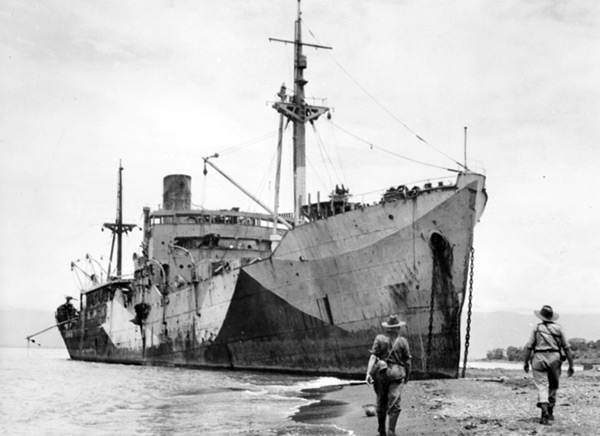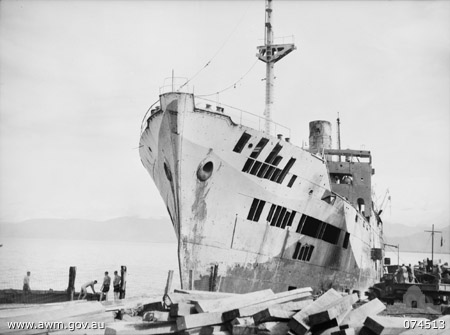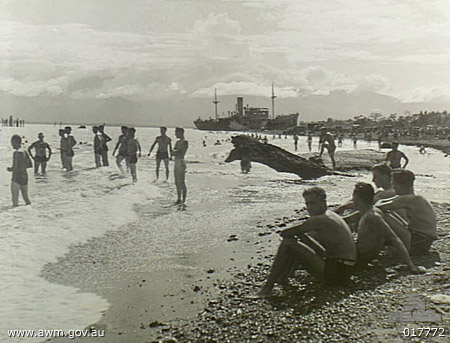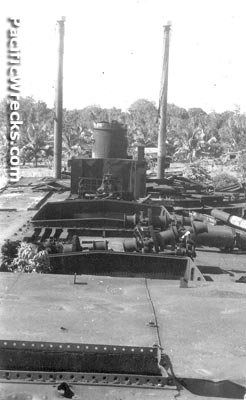|
|
|
|
| Missing In Action (MIA) | Prisoners Of War (POW) | Unexploded Ordnance (UXO) |
| Chronology | Locations | Aircraft | Ships | Submit Info | How You Can Help | Donate |
|
| IJN Cargo 4,100 Tons  Australia Army October 25, 1943  AWM May 5, 1944  AWM November 3, 1944  AWM 1945    Albert Cross 1956 |
Wartime History On January 6, 1943 the Myoko Maru left Rabaul as part of a convoy with three other transports, a light cruiser, and four destroyers. Spotted by RAAF aircraft and attacked along the way by 43rd BG B-17 bombers. On January 5, 1943 at noon, part of a convoy with the Imperial Japanese Army 51st Division embarked that departs Rabaul bound for Lae as part of Operation 18. The convoy is comprised of Brazil Maru, Chifuku Maru and Nichiryu Maru escorted by DesDiv 17's destroyers Maikaze and Urakaze, Tanikaze, Isokaze and Hamakaze. The convoy will proceed around the southern coast of New Britain bound for Lae. On January 7, 1942 during the night, as convoy arrives Lae on and further attacks were made without any obvious success. Sinking History On January 8, 1943 at 2:10pm a single P-40E Warhawk from 49th Fighter Group dropped a 300 pound bomb that scored a direct hit and destroyed the engine. The damaged ship was beached at Malahang across from the Butibum River, to the east of Lae. Japanese Army soldier "Nakajima" on a landing barge (via ATIS 208): "On the 8th early in the morning the enemy planes came again. At 1410 a bomb was dropped on No. 3 ship, Myoko Maru, near the lower part of the funnel. It destroyed the engine and rendered the ship un-manageable. Five Army members of the crew were wounded buy none was killed. At that time my MLC [landing barge] just left the Myoko Maru. I was covered in soot. My face was black, but no damage was done." On January 9 , 1943 at 8:30am the damaged and beach transport was bombed by B-17s from the 43rd Bomb Group (43rd BG) and scored four direct hits. Shipwreck This ship was still intact when the Allies captured Lae in September 1943. On board, they found cargo including bicycles, barbed wire and motorcycles. Its hull plates were begun to be salvaged by May 1944. Coal from the ship was used in the Australian Army camp at Lae. Post war, some wreckage including the propeller shaft remains in the sand. Adele Kelly adds: "I was born in Wau in 1941. As a young girl I remember going to the Myoko Maru to visit my "uncle" Jim Hoile and his wife Connie, who lived on the wreck! I do believe my father Dave Wood actually had the salvage rights to the ship, but am not sure. I remember going back out to the wreck in 1956 and there wasn't much left of it." By 1956 the ship was already well rusted and no visible sign of any name. Even the villagers didn't know. I believe it was totally scrapped. I have not been back to Wagen village since but in 1956 the wreck was visible from Voco Point, opposite the Hotel Cecil, in Lae as it was only 9 miles away but there was no sign of it when I visited Lae in later years. The Hotel Cecil I believe has also been demolished. It was a very large cargo ship around 7,000 tons I would say, and had been run aground with the bow up on the beach near Wagen village. Albert Cross recalls from 1956: "This vessel went aground near Wagen village. The vessel was, in 1956, already well rusted and no visible sign of any name. The wreck was visible from Voco Point, opposite the Hotel Cecil, in Lae as it was only 9 miles away but there was no sign of it when I visited Lae in later years. I believe it was totally scrapped. One of my friends in Lae in 1956 was Wally Jackson who was in the salvage business so I think he may have been involved in the vessels salvaging for scrap. I believe he is also dead now so I can't check with him either." Zadrach Ginuni remembers: "The village [near the wreck] is called Sipieya, 'meaning ship on fire'. The wreck of the ship is still there but gradually disappearing. I have personally seen the ship and know the story behind it as I grew up in Lae. During WWII, my father was a small child and he has passed stories onto me over the years." References X Marks the Spot by David Pennefather Myoko Maru reference Protect & Avenge: The 49th Fighter Group in World War II (1995) page 183 (aerial photo) Ken's Men Against The Empire The Illustrated History of the 43rd Bombardment Group During World War II Volume I: Prewar to October 1943 The B-17 Era (2020) pages 116 (Jan 9, 1943) Contribute
Information |
Photo Archive |
| Discussion Forum | Daily Updates | Reviews | Museums | Interviews & Oral Histories |
|